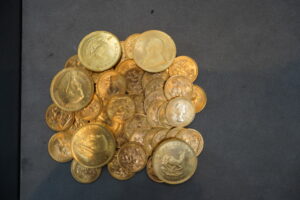Understanding Pyrite and Real Gold
The mineral pyrite is an iron-sulfide with a pale yellow brassy luster. It’s often confused with gold. The crystalline form of pyrite is usually cubical or octahedral, which sets it apart from real gold’s more malleable nature. The yellow color of gold, which is the precious metal’s most distinctive feature, as well as its softness and density, make it a popular choice.
The Differences between Pyrite and gold
Both minerals are yellowish, but gold is brighter and more consistent. Pyrite, on the other hand, tends to be brassy yellow with an iridescent sheen. The lustre of gold remains constant in any lighting condition, while pyrite can lose its shine in dim light.
Gold is relatively soft, and can be easily scratched with a knife or a coin of copper. The hardness of Pyrite is between 6 and 6, indicating a greater level of durability. It can scratch glasses and resists scratches by softer materials.
It is malleable, ductile and can be drawn or hammered to thin sheets without it breaking. Pyrite, on the other hand, is fragile and can break or crumble when under pressure.
Gold is heavier than its weight due to its density. It has a specific gravity of 19.3. The specific gravity of pyrit is lower, at around 5. It feels lighter compared to gold.
Pyrite is usually found in sharply-edged cubical or octahedral crystalline forms. Gold is usually found as irregular nuggets or flakes with no definite crystal structure.
The colour of the powdered mineral is revealed by rubbing a mineral on a porcelain plate that has not been glazed. The gold leaves a streak of yellow, while pyrite is a streak that’s greenish-black to brownish black.
Because of its sulfur content, it may give off a slight sulfuric smell or “bad egg” smell when scratched or struck. The gold is completely odourless.
Useful tests to distinguish between Pyrite and gold
Under good light, examine the specimen. You’ll want to look for the crystalline shape of pyrite and its brassy color, rather than gold’s buttery, yellowish appearance.
Use a knife or copper coin to scratch the mineral. It is most likely pyrite if the mineral resists scratches by the steel knife or scratches copper. It may be made of gold if it scratches easily. Use caution when performing this test in order to prevent damaging an expensive gold specimen.
Apply pressure to the object with a pin or a soft hammer. The gold will bend or flatten without breaking. Pyrite, on the other hand, will shatter or crack due to its fragility.
The streak colour will be revealed by dragging the sample across a porcelain plate that is not glazed. A streak of yellow indicates gold while a streak of greenish black suggests pyrite.
To calculate density, weigh the sample in both air and water. The higher density of gold will lead to a higher specific gravity for pyrite. For accurate measurements, this test could require precision equipment.
Gold and pyrite, while generally not magnetic, can have traces of elements with slight magnetism. Bring a magnet near the specimen to check for pyrite.
Common misconceptions and additional considerations
Chalcopyrite is another mineral that can be confused with gold. It has a yellowish brassy appearance. It is distinguished from gold and pyrite by its lower hardness of 3.5 to 4.
Take into consideration the locati0n of the specimen. Placer deposits, rivers, and streams are often where gold is found, whereas pyrite can be located in a variety of geological formations including sedimentary rock and hydrothermal veins.
If you are unsure, contact a geologist for advice or send the sample to an assaying office. The assay office can also perform sophisticated tests such as X-ray Fluorescence (XRF), to identify the composition of the minerals.
While gold and pyrite may look similar, simple visual tests and inspections can help distinguish the two. Even a beginner can tell if their gold is real or fool’s Gold by evaluating factors like colour, texture, streak and malleability.
Professional testing techniques such as advanced X-ray Fluorescence analyses or specific gravity measurements can give definitive answers to those who are still uncertain. These differences are invaluable to collectors and prospectors. They can help them avoid expensive mistakes, and concentrate on the true treasures.
Fool’s Gold may have some aesthetic and scientific value but is no substitute for the lasting allure of real gold. Consult a reliable source or a gold expert for more information on how to identify and value gold. You can distinguish between gold and pyrite with the help of the correct knowledge and tools.

